
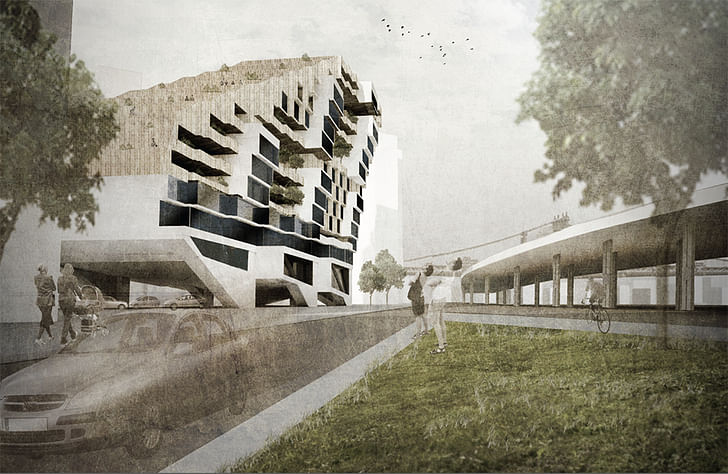
Responding to a daunting list of post-Sandy urban concerns, M.Arch students at the Parsons New School for Design proposed a variety of affordable housing complexes in an under-developed patch of Manhattan’s Lower East Side.
The historic “Two Bridges” neighborhood is a perfect storm of urban challenges, and post-Sandy, the area became a broader target in discussions of disaster resiliency, affordable housing, resource access, sustainability and social diversity. It was a ripe site for Andrew Bernheimer and David Leven to focus their Housing Studio, and has since attracted more attention after the New York City Housing Authority’s announced it would develop market-rate housing on the same plot.
Responses from one of the participating students, Ayesha Ghosh, are quoted throughout the article.
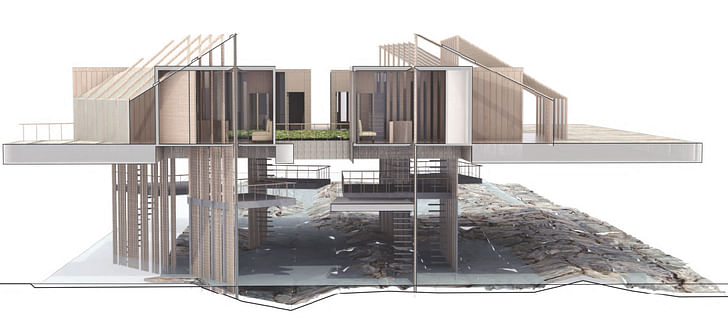
Studio Report: Dwelling and Resilience, Parsons School of Constructed Environments M.Arch
Studio leaders: Andrew Bernheimer and David Leven
This year’s housing studio is positioned in direct relation to momentous paradigm shifts in the ways that New York City approaches resilience relative to climate change and urban natural systems. Following Hurricane Sandy (which occurred during the first semester of these students’ Master of Architecture education and which disrupted an already intense initiating semester), various initiatives and projects have arisen in New York and along the cities of the eastern seaboard. This studio positioned itself as one such reexamination, encouraging the students to explore new ways of designing architecture in the face of daunting environmental parameters and seemingly dire expectations. Central to the studio was the focus and attention to the needs of urban dwelling with a renewed approach to resilience, both environmental and architectural, reframing the way that housing is conceived.
Site analysis and repeated visits reaffirmed the necessity for accessibility to healthy and affordable food choices. Housing and Neighborhoods as a topic comprises the first section of New York City’s PlaNYC 2030*, a document envisioning the future metropolis. The introduction to “The Plan” proposes a “bold agenda to build a greater greener New York”, and clearly states a commitment to affordable, sustainable, transit-oriented housing. This studio envisioned strong synthetic links with infrastructure and natural systems while addressing the necessities of aggregated, dense dwelling, the traditions of architectural housing relative to New York City, and concepts of neighborhood. Further, within the context of public housing’s dire need for systemic upgrading, the studio considered the vacant land surrounding tower blocks on the water’s edge in Manhattan as a place of opportunity, contested ground in terms of real estate, aesthetics, and environment.

As most NYC public housing (owned and run by the New York City Housing Authority, or “NYCHA”) is on lots that are significantly under-built, with large swaths of green spaces surrounding them (“towers in the park”), there exist massive development rights that are being left untapped. This developable square footage (Floor Area Rights, or “FAR” to those in the development sphere) presents opportunity, an untapped, city-owned asset. The students were therefore challenged to contemplate occupying this ground without compromising it, with inhabiting a village without disrupting it, with altering an urban environment without simply creating defensive architecture. The studio resulted in visions of affordable social housing that actively confront antagonistic relationships between those that dwell in a city and the environment that is rapidly changing it.
The class ultimately grappled with ideas of resilient architecture, food justice, and the social implications of design. The studio proceeded in three stages. The first exercise was narrative-based and site-less, in which students envisioned a compressed space for two occupants. Without limitation on materials and without any specificity about who these occupants might be, the students were left to craft the story of two dwellers, establishing their characters’ relationship while choreographing their interactions, all within a compact amount of space. This was a space of negotiation.
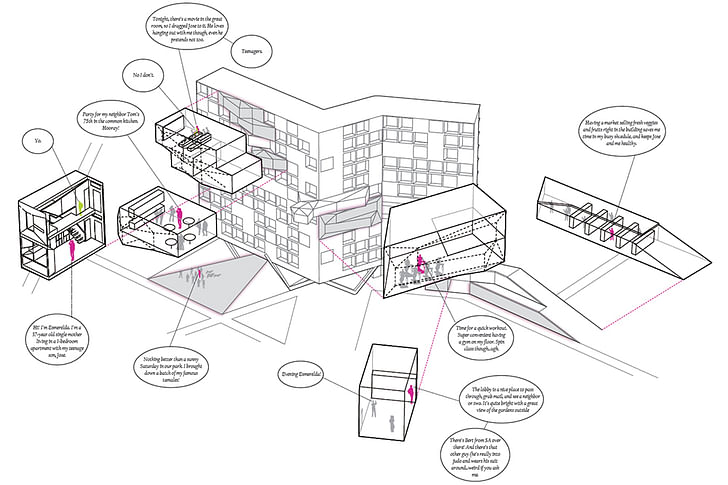
Next, students analyzed the given site within the city – in this case the land surrounding the Alfred E. Smith Houses on Manhattan’s Lower East Side along with the neighborhoods that encompass and abut this 12-tower, 22 acre complex. The Smith Houses, built in the early 1950s, contain over 1,900 apartments and over 5,500 occupants, of which more than 30% are elderly*. Site analyses were done at coarse, medium, and fine grains, and visually qualified and quantified the conditions of the place, the means of access to and from this location, the demographics, and the environmental/natural parameters. The analyses were catalytic, meant to draw forth discussions of program, social pressures, and infrastructural need within the context of the place. The third (and final) assignment was the aggregated housing design, for which pairs of students had ten weeks of time. This project required the design of an approximately 100,000 square foot mixture of unit types along with a public market space, all in a location radically impacted by the inundation from Sandy.
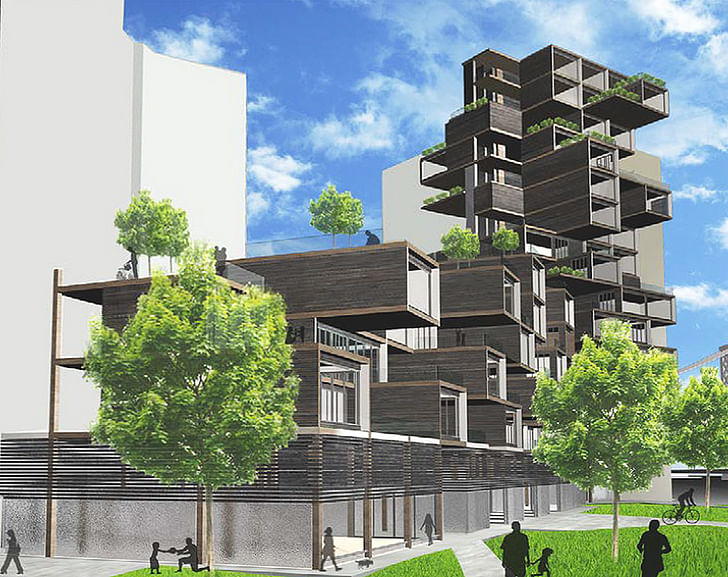
Coincidentally and just a few weeks into the running of this studio NYCHA announced their intentions to offer land-leases for this site (and several others) to qualified developers*. Their goal is to support the development of a mixture of affordable and market-rate housing on this under-developed acreage, utilizing the proceeds from the land-leases to fund the upkeep and modernization of the associated public housing. The work of these students thus presaged a vital, critical process related to social and environmental opportunism.
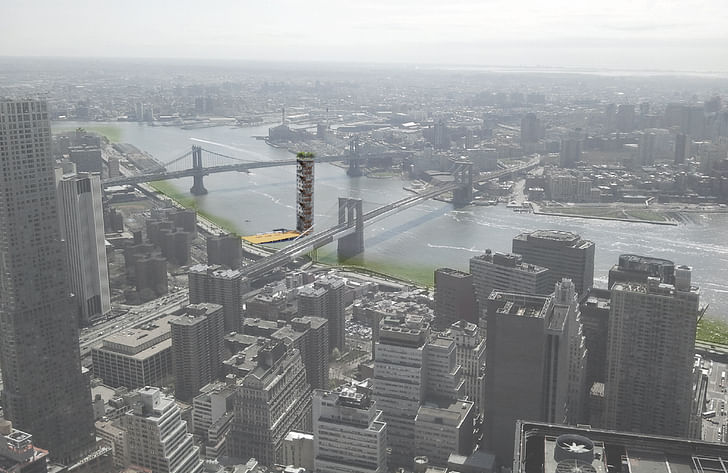
About the Parsons housing studio:
The second in the series of six required design studios in the graduate curriculum at Parsons is the housing studio. In this studio students study various conditions particular to housing including the part (the unit) the whole (the housing building), public, semi-public/semi-private, private space, urban and ecological issues and precedents of housing schemes. Issues such as culture, technology, history, theory and applicable zoning regulations receive critical readings in this studio. This is done with an understanding that diagrams, drawings, and models – architectural conventions – are a form of thought and the language with which invention, rigor, and discovery are expressed.
Former Managing Editor and Podcast Co-Producer for Archinect. I write, go to the movies, walk around and listen to the radio. My interests revolve around cognitive urban theory, psycholinguistics and food.Currently freelancing. Be in touch through longhyphen@gmail.com
No Comments
Block this user
Are you sure you want to block this user and hide all related comments throughout the site?
Archinect
This is your first comment on Archinect. Your comment will be visible once approved.